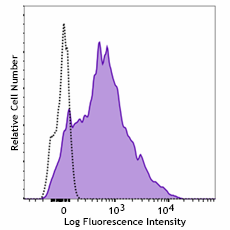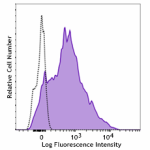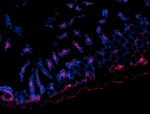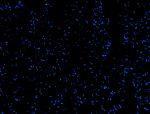- Clone
- W21055C (See other available formats)
- Regulatory Status
- RUO
- Other Names
- ICAM-1, Ly-47
- Isotype
- Rat IgG2a, κ
- Ave. Rating
- Submit a Review
- Product Citations
- publications

-

C57BL/6 mouse splenocytes stained with purified anti-mouse CD54 (clone W21055C) (filled histogram), or purified rat IgG2a, κ isotype control (open histogram), followed by anti-rat IgG PE. -

IHC staining of anti-mouse CD54 (clone W21055C) on C57BL/6 mouse frozen small intestine. After fixing with 4% paraformaldehyde (PFA) for ten minutes, the tissue was incubated with 10 µg/mL of purified anti-mouse CD54 (clone W21055C) overnight at 4°C, followed by incubation with 2.5 µg/mL of anti-rat IgG Alexa Fluor® 594 (red) (Cat. No. 405422) for two hours at room temperature. Nuclei were counterstained with DAPI (blue) (Cat. No. 422801). The image was captured with a 10X objective. -

IHC staining of anti-mouse CD54 (clone W21055C) on C57BL/6 mouse frozen brain tissue (negative control). After fixing with 4% paraformaldehyde (PFA) for ten minutes, the tissue was incubated with 10 µg/mL of purified anti-mouse CD54 (clone W21055C) overnight at 4°C, followed by incubation with 2.5 µg/mL of anti-rat IgG Alexa Fluor® 594 (red) (Cat. No. 405422) for two hours at room temperature. Nuclei were counterstained with DAPI (blue) (Cat. No. 422801). The image was captured with a 10X objective.
| Cat # | Size | Price | Quantity Check Availability | Save | ||
|---|---|---|---|---|---|---|
| 165902 | 100 µg | 105 CHF | ||||
CD54, also known as ICAM-1 and Ly-47, is a 90 kD immunoglobulin superfamily member. It is expressed on activated endothelial cells, high endothelial venules (HEV), T and B cells, monocytes/ macrophages, granulocytes, and dendritic cells. CD54 is an important intracellular adhesion molecule that participates in T cell-T cell, T cell-B cell, and T cell-target cell interactions via binding of LFA-1 (CD11a/CD18) and Mac-1 (CD11b/CD18). CD54 has also been shown to be involved in lymphocyte trafficking, making it an important molecule in many immune reactions and inflammation. CD54 is also a receptor for rhinovirus. The YN1/1.7.4 antibody has been reported to block binding of mouse CD54 to LFA-1 and Mac-1, inhibit cell-cell adhesion, and function in antigen presentation to T cells and leukocyte migration to inflammatory tissues.
Product DetailsProduct Details
- Verified Reactivity
- Mouse
- Antibody Type
- Monoclonal
- Host Species
- Rat
- Immunogen
- Mouse ICAM-1 (28-485) with human Fc chimera plus transfectant (full length)
- Formulation
- Phosphate-buffered solution, pH 7.2, containing 0.09% sodium azide
- Preparation
- The antibody was purified by affinity chromatography.
- Concentration
- 0.5 mg/mL
- Storage & Handling
- The antibody solution should be stored undiluted between 2°C and 8°C.
- Application
-
FC - Quality tested
IHC-F - Verified - Recommended Usage
-
Each lot of this antibody is quality control tested by immunofluorescent staining with flow cytometric analysis. For flow cytometric staining, the suggested use of this reagent is ≤ 0.5 µg per million cells in 100 µL volume. For immunohistochemal staining on frozen tissue sections, a concentration range of 5.0 - 10.0 µg/mL is suggested. It is recommended that the reagent be titrated for optimal performance for each application.
- RRID
-
AB_3097209 (BioLegend Cat. No. 165902)
Antigen Details
- Structure
- Ig superfamily, 90 kD
- Distribution
-
Activated endothelial cells, high endothelial venules, T cells and B cells, monocytes/macrophages, granulocytes, dendritic cells
- Function
- Immune reaction, inflammation, adhesion
- Ligand/Receptor
- CD11a/CD18 (LFA-1) or CD11b/CD18 (Mac-1) and CD11c/CD18, CD43, hyaluronan, fibrinogen
- Cell Type
- B cells, Dendritic cells, Endothelial cells, Granulocytes, Macrophages, Mesenchymal Stem Cells, Monocytes, T cells
- Biology Area
- Cell Adhesion, Cell Biology, Costimulatory Molecules, Immunology, Innate Immunity, Neuroscience, Neuroscience Cell Markers, Stem Cells
- Molecular Family
- Adhesion Molecules, CD Molecules
- Antigen References
-
- Barclay AN, et al. 1997. The Leukocyte Antigen FactsBook Academic Press.
- Springer TA. 1990. Nature. 346:425-34.
- Rothlein R, et al. 1986. J Immunol. 137:1270.
- Gene ID
- 15894 View all products for this Gene ID
- UniProt
- View information about CD54 on UniProt.org
Related FAQs
Other Formats
View All CD54 Reagents Request Custom Conjugation| Description | Clone | Applications |
|---|---|---|
| Purified anti-mouse CD54 | W21055C | FC,IHC-F |
Compare Data Across All Formats
This data display is provided for general comparisons between formats.
Your actual data may vary due to variations in samples, target cells, instruments and their settings, staining conditions, and other factors.
If you need assistance with selecting the best format contact our expert technical support team.
 Login / Register
Login / Register 











Follow Us